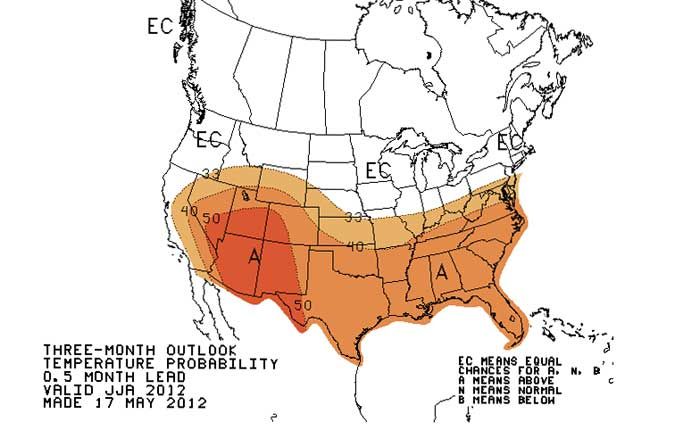
Hot Summer Projected for Much of US

More than half of the United States may be in for a hot summer, a continuation of a year-long trend of high temperatures across much of the country, according to scientists with federal agencies that monitor large-scale climate conditions and severe weather.
During a teleconference today (May 17), scientists with the National Oceanic and Atmospheric Administration unveiled a map that showed projections for above-average temperatures for June, July and August for the lower two-thirds of the country, from California to the Eastern Seaboard and stretching as far north as Wyoming and central Illinois.
Southwestern states are projected to experience the most dramatic departures from typical summer temperatures.
Hot trend
The forecast for sticky summer weather follows on the heels of record-breaking weather conditions across much of the country for the first part of 2012, according to the data presented at the teleconference.
Across the globe, April 2012 was the fifth warmest April on record.
It was the third-warmest April on record in the United States, with almost all of the country experiencing warmer than average temperatures, said Jake Crouch, a climatologist with the National Climatic Data Center.
Sign up for the Live Science daily newsletter now
Get the world’s most fascinating discoveries delivered straight to your inbox.
"April followed on the heels of an extremely warm March," Crouch said. That month was the warmest March on record for the United States; every state in the nation experienced a record high temperature.
The spate of warm weather and an unseasonably mild winter have made the last 12 months — from May 2011 through April 2012 — the warmest consecutive 12 months on record for the contiguous United States since 1895, when record-keeping began. Overall, temperatures were 2.8 degrees Fahrenheit (1.5 degrees Celsius) warmer than the 20th-century average.
Trouble ahead?
A strong and persistent La Niña — a cyclical cooling of Pacific Ocean waters — has now exited the stage, but scientists said that there's little relief in sight for the southwest, which has been in the grip of the warm weather and drought conditions La Niña typically brings to the region.
"Given the prospect of hotter, drier conditions across the west, and wildfire activity in the southwest, we may see a pretty significant wildfire season developing across the southwestern United States," said Greg Carbin, the warning coordination meteorologist at the Storm Prediction Center.
Lighting strikes and wind are two of the biggest factors that can contribute to wildfires, Carbin added.
Wildfires have been burning in Arizona since early May; the state experienced devastating wildfires in the summer of 2011.
"When you're having wildfires this early, it isn't a good sign," Carbin said.
This story was provided by OurAmazingPlanet, a sister site to LiveScience. Reach Andrea Mustain at amustain@techmedianetwork.com. Follow her on Twitter @AndreaMustain. Follow OurAmazingPlanet for the latest in Earth science and exploration news on Twitter @OAPlanet and on Facebook.












